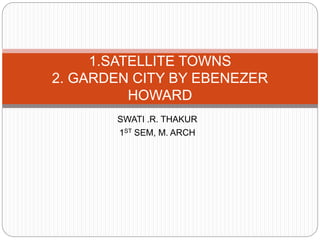The document discusses satellite towns and Ebenezer Howard's garden city movement. It defines satellite towns as towns that are under the influence of a larger parent city but have their own identity. Features of satellite towns include local government and connections to the parent city via transportation. Howard's garden city movement proposed limiting city sizes and incorporating greenbelts, agriculture, and industry into planned, self-contained communities surrounded by nature. Letchworth and Welwyn Garden City in the UK were early examples built using Howard's garden city principles.
















